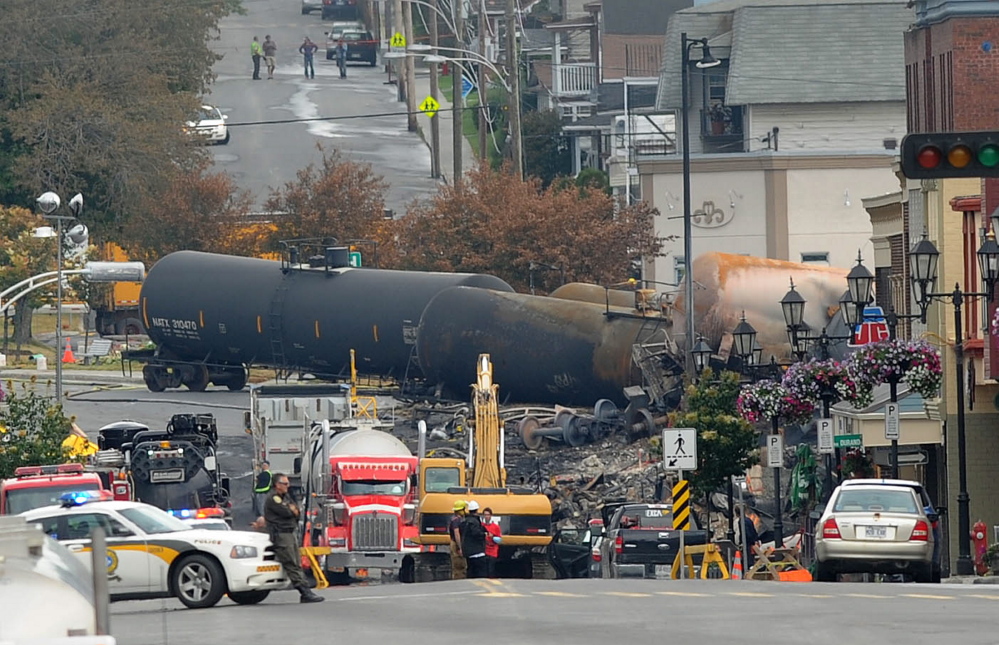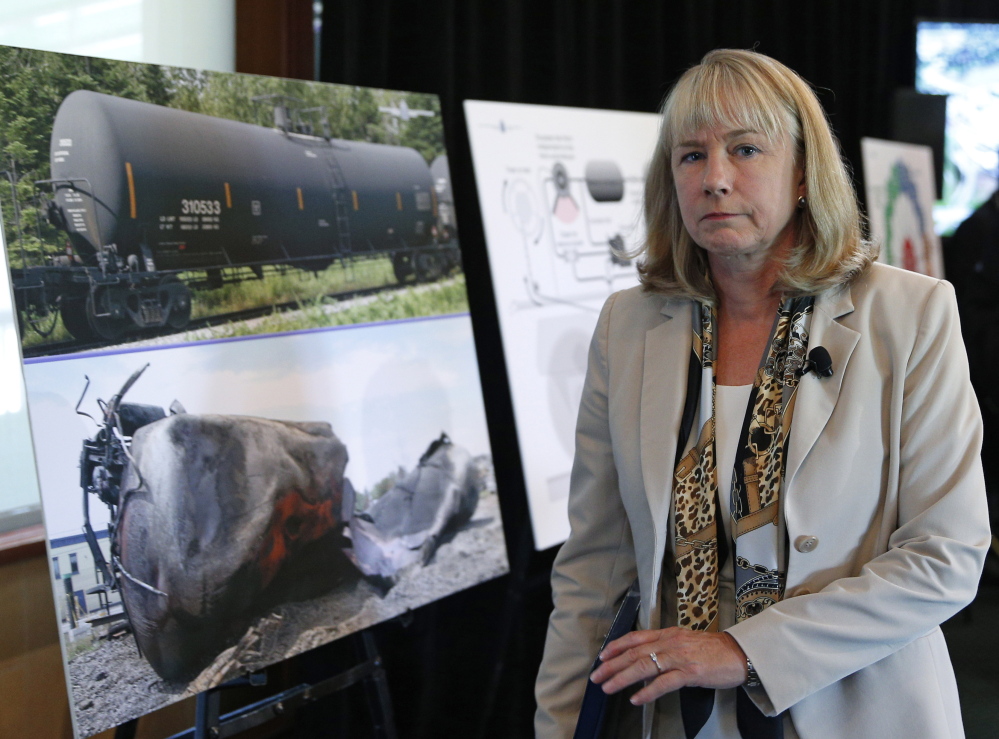The runaway train that exploded into a small Quebec village last year was operated by a small regional railroad that cut corners on safety to save money, the Transportation Safety Board of Canada said in its final report on the accident that killed 47 people.
“This was a company with a weak safety process,” said board chairman Wendy Tadros. “A company that did what it took to get the job done.”
But the report released Tuesday with a press conference in Lac-Mégantic, where the accident occurred, also found fault with Canadian regulators for their failure to oversee trains hauling millions of gallons of potentially explosive Bakken crude oil.
“Transport Canada knew about some of the problems, but the follow-up wasn’t always there,” Tadros said. “There has to be a change in the Canadian rail systems because we have to do more than just stick to the rules.”
The unmanned train with 72 tank cars full of crude oil roared into Lac-Mégantic after a seven-mile downhill run on July 6, 2013, derailing at 1:15 a.m. and releasing 1.5 million gallons of oil that burst into an inferno, the report said.
Though the Montreal, Maine & Atlantic Railway’s president, Edward Burkhardt, was quick to pin the blame last year on an engineer who he said failed to properly set the train’s brakes, the TSB report presented a more complex explanation for the disaster.
“In all, we found 18 factors that played a role,” Tadros said. “Take away any one of them and this accident may not have happened.”
Among them, she said, was that the railway “cut corners” in many areas, for example, opting to lower train speeds rather than make necessary repairs to the rails.
“We now know why the situation developed over time,” Tadros said. “It was a weak safety culture at MM&A, poor training of employees and tanker cars that didn’t offer enough protection.”
The railway filed for bankruptcy within weeks of the Lac-Mégantic crash, and three of its employees are facing criminal negligence charges.
The railway, which served Quebec, Maine and Vermont, had been in financial trouble since its formation in 2002 to serve the forest industry in the region. When key paper-plant customers shut down, it turned to the awakening demand to transport Bakken crude oil being produced through the fracking process.
The sudden desire to move vast volumes of crude oil by rail took Canadian regulators by surprise, Tadros said.
The TSB report said Transport Canada failed to audit the railway regularly or thoroughly enough “to ensure it was effectively managing the risks in its operations.”
The TSB on Tuesday added two new recommendations to three it made earlier.
It said Transport Canada should take a more active role in ensuring that railway safety management systems are effective, and it said railways should create better “physical defenses” to prevent runaways.
Like the U.S. Transportation Safety Board, the Canadian TSB’s role is confined to making recommendations on which regulatory agencies can act as they see fit. The TSB already had recommended better emergency response planning, smarter route planning to keep trains with hazardous loads away from population centers and better protections for a type of rail car — the Class 111 tank car.
The U.S. Department of Transportation last month zeroed in on the Class 111 cars, proposing rules that would require the phasing out of tens of thousands of them. Accident investigators say they are too quick to puncture or rupture. The Lac-Mégantic crash is one of 10 significant derailments since 2008 in the United States and Canada when oil has spilled from ruptured tank cars.
The TSB report said the train already had been parked seven miles uphill from the town when a fire occurred in one engine. Firefighters controlled the fire, shut down the locomotives and departed.
“With all the locomotives shut down, the air compressor no longer supplied air to the air brake system,” the report said. “As air leaked from the brake system, the main air reservoirs were slowly depleted, gradually reducing the effectiveness of the locomotive air brakes.”
The air brakes failed just before 1 a.m. and hand brakes that hadn’t been properly set could no longer hold the train. It began to roll downhill toward Lac-Mégantic, reaching a top speed of 65 mph.
The derailment and ensuing fire and explosions killed 47 people, forced another 2,000 from their homes and destroyed much of the downtown core in the village of fewer than 6,000 residents.
“This accident will bring about a sea change in the thinking of the railways, the shippers and the regulators,” Tadros said.
Send questions/comments to the editors.




Success. Please wait for the page to reload. If the page does not reload within 5 seconds, please refresh the page.
Enter your email and password to access comments.
Hi, to comment on stories you must . This profile is in addition to your subscription and website login.
Already have a commenting profile? .
Invalid username/password.
Please check your email to confirm and complete your registration.
Only subscribers are eligible to post comments. Please subscribe or login first for digital access. Here’s why.
Use the form below to reset your password. When you've submitted your account email, we will send an email with a reset code.